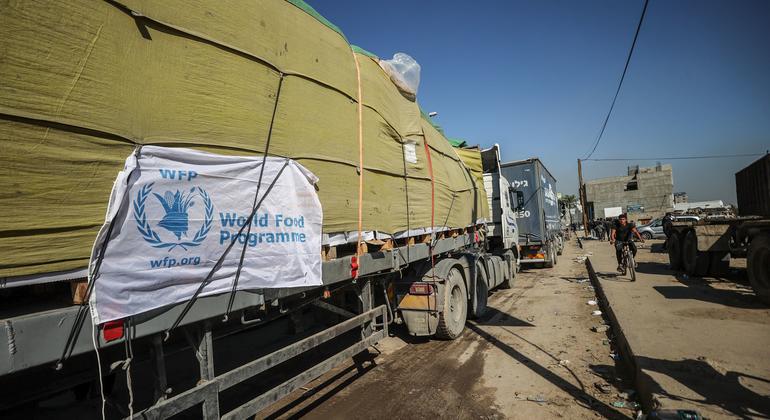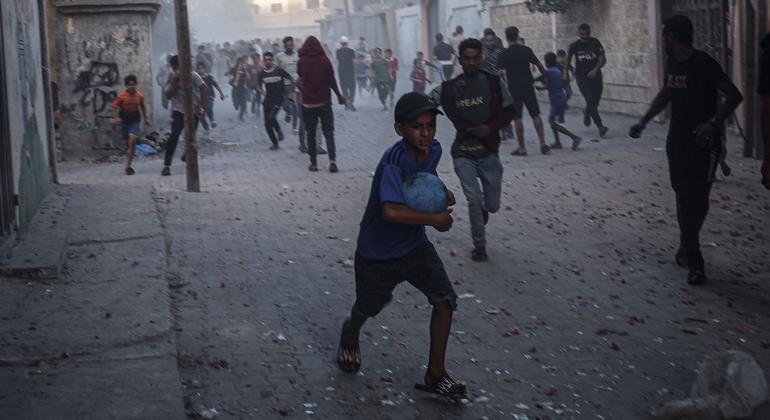Lynn Hastings stressed that the intensifying hostilities have pushed almost half of the population of the Strip, or about a million people, into Rafah in the south, compounding the dire health and hunger crisis.
“The reason why Gaza is not safe is not just because of the airstrikes but also because of these conditions created by the massive displacement of the population into smaller and smaller areas”, which also jeopardizes the humanitarian operation in the enclave, she said.
Call for access to hostages and detainees
Ms. Hastings also insisted that a ceasefire could be conducive to the release of hostages taken by Hamas during its deadly terror attacks in southern Israel on 7 October, and reiterated calls for access to the hostages.
Access for humanitarian partners the International Committee of the Red Cross (ICRC) should also be granted to medical staff who have been detained by Israeli forces, such as the director of the Al-Shifa hospital, which was the object of a military raid last month.
Ms. Hastings’ comments to journalists in Geneva from Jerusalem followed Tuesday’s overwhelming vote at the UN General Assembly in favour of an “immediate humanitarian ceasefire”, the immediate and unconditional release of all hostages and well as “ensuring humanitarian access”.
Most Gazans lack food
The UN official stressed that in Gaza infectious diseases are spreading, less than a third of all hospitals are at least partially functioning, shelters have long ago exceeded their capacity and the vast majority of people do not have enough food or water.
Almost half of the population in the north and one third in the south are experiencing “severe levels of hunger” according to a recent assessment by the UN World Food Programme (WFP).
Ms. Hastings underscored that Israel as the occupying power is responsible for the protection of Palestinian civilians in the enclave, providing for their basic needs and ensuring unimpeded aid access. That means not only allowing aid trucks to cross into Gaza but also enabling humanitarians to provide assistance to all those who require it, she said.
Markets must open
The UN Humanitarian Coordinator emphasized that the aid sector needs to work side by side with the public sector and the commercial sector “as we do everywhere else in the world” to support Gaza’s population properly.
“We need the markets to be open”, she said, and commercial goods to come in so that a malnutrition crisis can be avoided.
Ms. Hastings welcomed the screening of UN aid trucks at the Israeli-controlled Kerem Shalom border crossing on Tuesday for the first time since the start of the escalation. Some 80 trucks were verified and cleared there before being sent to Rafah in order to enter the enclave, she said.
She reiterated calls for the complete re-opening of Kerem Shalom crossing for both humanitarian and commercial traffic, which prior to 7 October was the main access point for goods into the Strip, and underscored that the Rafah crossing was structurally not intended for the passage of hundreds of aid trucks.
Stressing the integrity of the humanitarian operation, Ms. Hastings said that no concerns have been expressed to the UN by the Israeli authorities about any diversion of aid from its trucks in Gaza.

Attacks on UN premises
Addressing the question of safety of UN facilities in the Strip, Ms. Hastings mentioned the destruction using explosives by Israeli forces of a UN agency for Palestine refugees (UNRWA) school in Beit Hanoun in the north, reportedly on Tuesday, and stressed that the UN was not aware of any justification for this move.
She also said that despite deconfliction measures being taken, where the UN repeatedly informs the parties to the conflict where its facilities are located, 130 incidents have impacted deconflicted UN installations since 7 October and 62 of them have resulted in casualties. UNRWA estimates that at least 283 displaced people seeking safety in its shelters have been killed and almost 1,000 injured.
Infrastructure damage
According to satellite imagery, some 60 per cent of homes in Gaza have already been damaged or destroyed, Ms. Hastings said.
Addressing reports on the potential flooding of underground tunnels in Gaza with seawater by the Israeli military, Ms. Hastings warned that if it happened it would cause “severe damage” to the already compromised water and sanitation structure in the enclave, jeopardize the Strip’s “very fragile” ecosystem and create a risk of buildings and roads collapsing.
Violence and poverty in the West Bank
The UN humanitarian coordinator also highlighted the increasingly fragile situation in the occupied West Bank, where 464 Palestinians have already been killed this year, more than half since 7 October. Some 3,000 have been detained and it was not clear whether they would be charged and given a trial, she said. Settler violence was also on the rise, with an average of five incidents per day up from two per day last year.
With the suspension of permits for West Bank workers in Israel and in the settlements, and the disruption of trade with Israel, the lack of revenue transfers to the population of the territory is a “grave concern”, she said.



